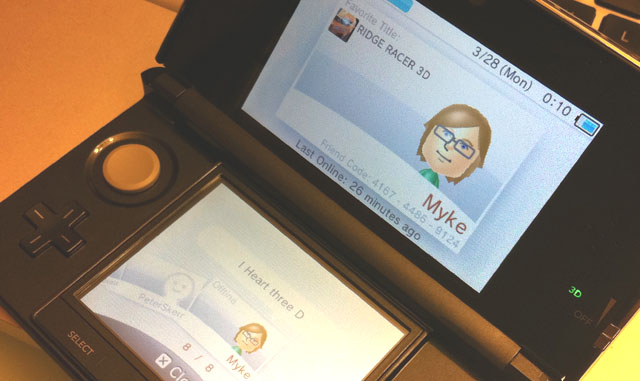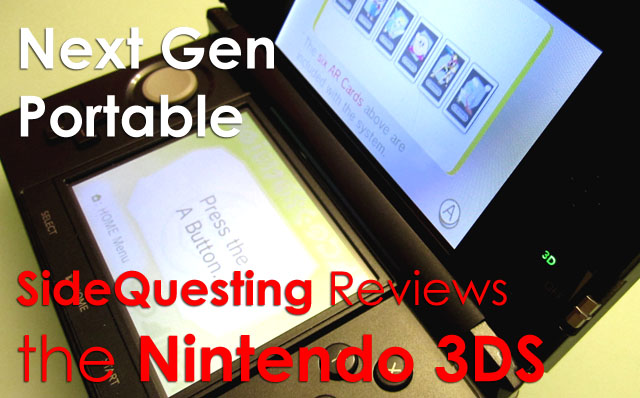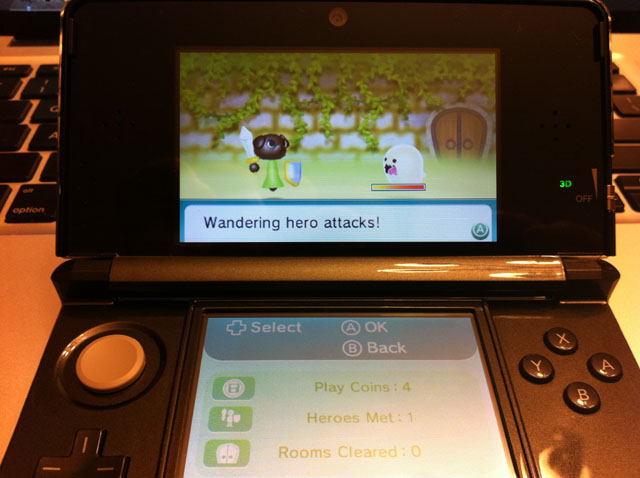Technology
3D. THREE-MUTHA-TRUCKIN’-DEE. And it works. The main gimmick for the 3DS, like motion on the Wii, is its glasses-free technology. As an FYI, the device’s 3D relies on autostereoscopy; meaning, it relies on each eye seeing a different image, so your pair of 20/20s needs to be in a pretty specific location to catch the effect. But when you do it works extremely well in providing depth, even on a small screen. The objects don’t pop out of the screen, they go back into space, so it’s not about things jumping out at you. It works great, and it alone is enough to enjoy the portable with. It doesn’t just add 3D, either. Nintendo thankfully improved the visual processors, allowing for more modern effects like lighting, higher textures and polygon counts, and higher resolution. It’s an improved experience all around.
Coupled with the two rear-facing cameras, the 3D effect is used in a variety of ways. The two cameras capture 2D and 3D photos, video (coming soon), and are the focus of the built in augmented reality games. I took photos of orchids, my daughter playing with her toys, and my wife pointing her finger at me, and each one turned out to provide a surreal amount of depth. The photos can even be saved onto an SD card and shared. It’s unfortunate, though, that the camera quality really isn’t all that great. The rear and front cameras all clock in around 0.3 MP each. The augmented reality especially works well, with the built in AR Games acting like the system’s Wii Sports to provide several tech demos for what the system will accomplish in the years to come.
Nintendo follows up the Wii’s stand with a similar one for the 3DS, perfect for viewing any 3D video… whenever it arrives. Simply placing it on its cradle allows the 3DS to charge, engaging a couple of prongs in the back instead of plugging a cord directly into it. It seems completely unnecessary but proves to be a somewhat neat addition. It may also have been a way to combat the “even horrible by 2007’s standards” battery life, which clocks in around 4 hours when the 3D is turned up and the WiFi turned on. Yuck.
Other results of Nintendo’s desire to cut corners fall with the ancient resistive touch screen (no multi-touch!) and the poor-quality speakers. This is where the majority of mobile phones out there already surpassed it… 3 years ago.
User Interface

Hallelujah, Nintendo. It’s about time. Kinda. The 3DS aims to be everything we wanted in a modern Nintendo game system. While it doesn’t quite make it there — this, too, seems a bit rushed to market and still in “beta” — it employs some great forward-thinking technology. The layout of the screen is very much like the Wii and iPhone, with rows of icons leading to different types of software, settings and games. It’s easy to traverse, and fairly easy to find and change settings.
Dali’s Friend Code: 4468-0970-1569
There is now only one Friend Code needed to connect in games, which allows for a buddy list that shows what 3DS friends are playing, much like EVERY OTHER MODERN CONSOLE. The same friends show up in lobbies of online-enabled games, like Super Street Fighter IV 3D, for play. The buddy list features aren’t fully-flushed out yet — you can’t see the stats of your friends for the games they’ve played, can’t send them messages or invites — but it’s a start, and one that we’ve waited for Nintendo to make since the original DS first launched. I just hope they capitalize on it and make it even a tenth as viable as Xbox Live.
Earlier, I mentioned that augmented reality was a feature that the 3DS included. Best showcased through the built-in AR Games and Face Raiders, the augmented reality uses all three cameras in some pretty novel ways, as well as motion-tracking and 3D. In AR Games, players point the dual 3D cameras on a specific card placed on a surface. The 3DS reads the card in space, and on the 3D screen it maps out targets, obstacles, and even dragons in a variety of minigames. The effect shows off an emerging gaming trend that until now has only really been done sparingly on mobile phones. I found myself sticking the cards on tables, rugs, marble, and even on a window to see what would happen. This level of exploration is what makes the games more enjoyable. As short tech demos, they serve the purpose of providing a bit of “WOW!”
Augmented reality and 3D aside, the feature that most got me excited was Streetpass, Nintendo’s method of roping us into carrying our 3DSes with us everywhere… and for good reason. Many of the games create Streetpass files, which allow the sharing of small bits of information between 3DSes in passing. This data can lead to acquiring a simple update or message, or can even send over a Mii to fight a battle in the built-in RPG, or a Street Fighter trophy to duke it out for virtual prizes. It’s a meta-game that only takes place when the 3DS is in storage. It’s ingenious. In order to compete against mobile phones, Nintendo needs to make the 3DS a “must carry” device. Now, I’ll always have it with me, whether I decided to play with it or not, knowing that it’s possibly crunching away on something that will benefit me when I do. Games are constantly being played on the handheld, even if I’m not.



No Comments